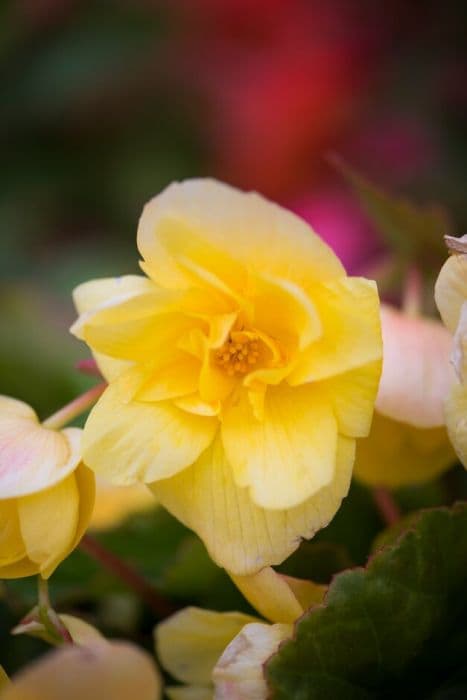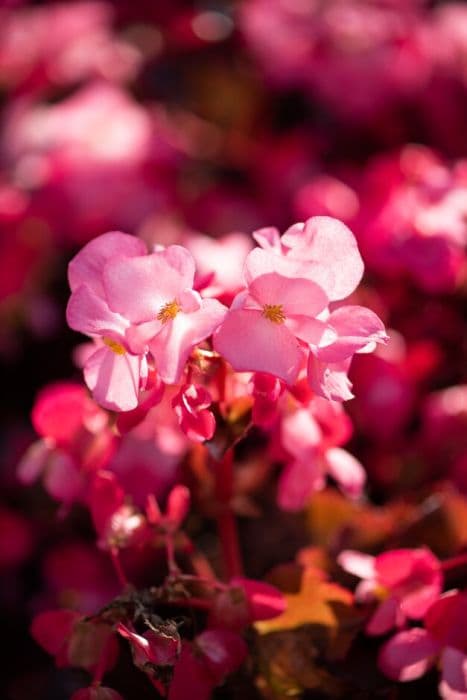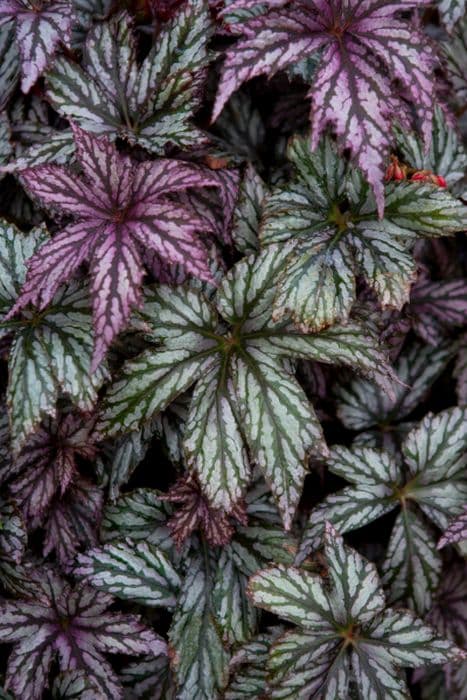Mikado Begonia Begonia 'Mikado' (R)

ABOUT
Begonia 'Mikado' is a striking ornamental plant known for its distinctive foliage and attractive flowering habits. The leaves boast a remarkable appearance with their asymmetrical, heart-shaped form that has a spiraled, twisted point, giving them a somewhat quirky and intriguing structure. The foliage is characterized by a rich, dark green hue, topped with a layer of fine hairs that impart a subtle sheen or sparkle, especially under the right lighting conditions. The leaves often feature a contrasting pattern of veins or markings, which adds to the visual interest of the plant. The Begonia 'Mikado', as part of its captivating look, produces flowers that contribute to its ornamental value. These blossoms can range in color, typically appearing in warm shades that provide a lovely pop of color against the dark foliage. The flowers grow in clusters that emerge on delicate stems above the leaves, displaying a gentle yet showy burst of color that is sure to catch the eye. This plant has an overall bushy and mounding growth habit that makes it particularly suitable as a houseplant or as part of a shaded garden arrangement. Its compact and lush foliage, paired with its floral display and unique leaf shape, makes the Begonia 'Mikado' a popular choice for those who enjoy plants with a strong visual appeal and a touch of unconventional charm.
About this plant
 Names
NamesFamily
Begoniaceae
Synonyms
Mikado Begonia
Common names
Begonia 'Mikado'
 Toxicity
ToxicityTo humans
The Begonia 'Mikado' is not highly toxic to humans but can cause irritation if ingested or if the sap comes in contact with skin. If ingested, it may cause mild discomfort in the mouth, difficulty swallowing, and stomach upset. It is advisable to avoid consuming any part of the plant and wash hands after handling it to prevent irritation.
To pets
Begonia 'Mikado' can be toxic to pets, especially cats and dogs. If ingested, it can cause vomiting, salivation, and difficulty swallowing due to irritation in the mouth and gastrointestinal tract. In severe cases, it may lead to kidney failure. It is important to prevent pets from chewing on any part of the plant and seek veterinary attention if ingestion occurs.
 Characteristics
CharacteristicsLife cycle
Perennials
Foliage type
Evergreen
Color of leaves
Varies
Flower color
Varies
Height
1 foot (30 cm)
Spread
1 foot (30 cm)
Plant type
Herb
Hardiness zones
10
Native area
Asia
Benefits
 General Benefits
General Benefits- Decorative Appeal: Begonia 'Mikado' adds aesthetic value with its unique spiral leaves and striking colors.
- Low Maintenance: Requires minimal care, making it suitable for busy individuals or those new to gardening.
- Long Blooming Period: Offers a prolonged display of flowers, often lasting throughout the summer.
- Compact Size: Its small size fits well in limited spaces like apartments or small gardens.
- Adaptability: Can be grown indoors in containers or outside in suitable climates, offering versatility for plant placement.
- Drought Tolerance: Once established, it can tolerate periods of dryness, reducing the need for frequent watering.
- Pest Resistance: Generally resistant to common pests, reducing the need for chemical treatments.
- Propagation Ease: Can be easily propagated from leaf cuttings or division, allowing gardeners to create more plants.
 Medical Properties
Medical PropertiesThis plant is not used for medical purposes.
 Air-purifying Qualities
Air-purifying QualitiesThis plant is not specifically known for air purifying qualities.
 Other Uses
Other Uses- The leaves of the Begonia can be used as decorative additions to gift wrapping or greeting cards for a natural, botanical aesthetic.
- Begonia petals can be incorporated into potpourris for their colorful appearance, although they have no significant fragrance.
- Pressed Begonia flowers can create beautiful natural art, which can be framed or used in bookmarks or phone cases.
- Begonia leaves can be used as natural stencils for crafting and painting projects.
- During educational activities, parts of the Begonia can be used to teach children about plant biology and the lifecycle of plants.
- Petals of the Begonia can be added to bathwater for a visually luxurious bath experience, without expecting other benefits.
- Fine dining restaurants sometimes use edible varieties of Begonia to garnish plates, adding a touch of elegance (Note: Not all Begonia species are edible; 'Mikado' may not be suitable for consumption).
- Begonia plants can be used as living ornaments during festive seasons, especially when they exhibit vibrant foliage and flowers.
- The Begonia can be a subject in photography, offering a rich palette of colors and textures for macro photography enthusiasts.
- The patterned leaves of the Begonia can be used as inspiration for textile designs, including apparel and home decor.
Interesting Facts
 Feng Shui
Feng ShuiThe Begonia is not used in Feng Shui practice.
 Zodiac Sign Compitability
Zodiac Sign CompitabilityThe Begonia is not used in astrology practice.
 Plant Symbolism
Plant Symbolism- Caution - Begonia often symbolizes a warning to be cautious or a sense of carefulness.
- Harmony - The balanced growth and overall aesthetic of the 'Mikado' Begonia may represent harmony and a peaceful state of balance.
- Fertility - With its lush leaves and growth patterns, begonias may represent fertility and fullness of life.
- Uniqueness - The unique spiraled shape of the 'Mikado' Begonia's leaves can stand for individuality and distinctiveness.
- Gratitude - Begonia is thought to express gratitude or thankfulness, making it a perfect gift to show appreciation.
 Water
WaterFor the Iron Cross Begonia, the watering schedule should maintain evenly moist soil; typically, water when the top inch of soil feels dry to the touch. Depending on environmental conditions, this might equate to watering once every week or once every two weeks with about 8 to 16 ounces of water each time, ensuring even distribution across the soil without waterlogging the plant. During the winter months, reduce watering frequency as the plant enters a dormant period.
 Light
LightIron Cross Begonias thrive in bright, indirect light, avoiding direct sunlight that can scorch their leaves. A north-facing or east-facing window would provide the ideal light conditions, while diffused light through a sheer curtain can help in more intense sunlit areas.
 Temperature
TemperatureIron Cross Begonias prefer a temperature range of about 60°F to 75°F, making them suitable for indoor living spaces. They can tolerate a minimum temperature down to around 50°F but should not be exposed to temperatures below this point. The optimum growing temperature for these plants lies within the 65°F to 70°F range.
 Pruning
PruningPruning Iron Cross Begonias is important to remove dead or yellowing leaves and to encourage bushier growth. The best time for pruning is in the spring, and occasional pinching back of the stems can be done throughout the growing season to maintain the plant's shape.
 Cleaning
CleaningAs needed
 Soil
SoilThe Spiral Begonia prefers a well-draining, peat-based potting mix with perlite or sand to increase aeration, with an optimal pH range of 5.5 to 6.5.
 Repotting
RepottingSpiral Begonias should be repotted every 1-2 years or when the plant becomes root-bound to ensure continued growth and health.
 Humidity & Misting
Humidity & MistingSpiral Begonias thrive in high humidity conditions, ideally between 50% and 70%.
 Suitable locations
Suitable locationsIndoor
Place in bright, indirect light; maintain high humidity levels.
Outdoor
Protect from direct sun; keep in warm, sheltered area.
Hardiness zone
10-11 USDA
 Life cycle
Life cycleThe life of a Begonia 'Mikado' typically begins with seed germination, where the tiny seeds sprout when provided with the right conditions of warmth and humidity. After germination, the seedlings grow into juvenile plants, developing characteristic foliage and a strong root system. The plant then enters a vegetative state where it grows larger leaves and stems, focusing on increasing its biomass. As the plant matures, it enters the flowering stage, producing its distinctive blooms, often in a range of colors that may include shades of pink, red, or white. After pollination, the flowers produce seeds, which can be dispersed to start new Begonia 'Mikado' plants, completing the reproductive cycle. Finally, during the end of its life cycle, the Begonia 'Mikado' may experience senescence, where growth slows and the plant begins to decline, eventually leading to death.
 Propogation
PropogationPropogation time
Spring-Summer
The Begonia 'Mikado', also commonly known as 'Spiral Begonia', is best propagated through leaf cuttings, a method widely appreciated for its simplicity and effectiveness. The optimal time to undertake this process is during the warmer months, from spring through summer, when the plant is actively growing. To propagate via leaf cuttings, a healthy leaf is selected and a cut is made across the main veins on the backside of the leaf. The leaf is then placed on a moist potting mix and secured in place, ensuring the cut veins contact the soil. The pot is then covered with a plastic bag to maintain humidity and placed in a warm area with indirect light. The leaf will soon develop roots and new shoots at the sites of the cuts, which can later be potted as individual plants once they’ve grown sufficiently, typically after a few weeks.





![Begonia [Devotion]](/_next/image?url=https%3A%2F%2Fplants-admin.emdemapps.com%2Fimages%2Fplants%2F%2Fimages%2F604b58183573b.png&w=640&q=75)



